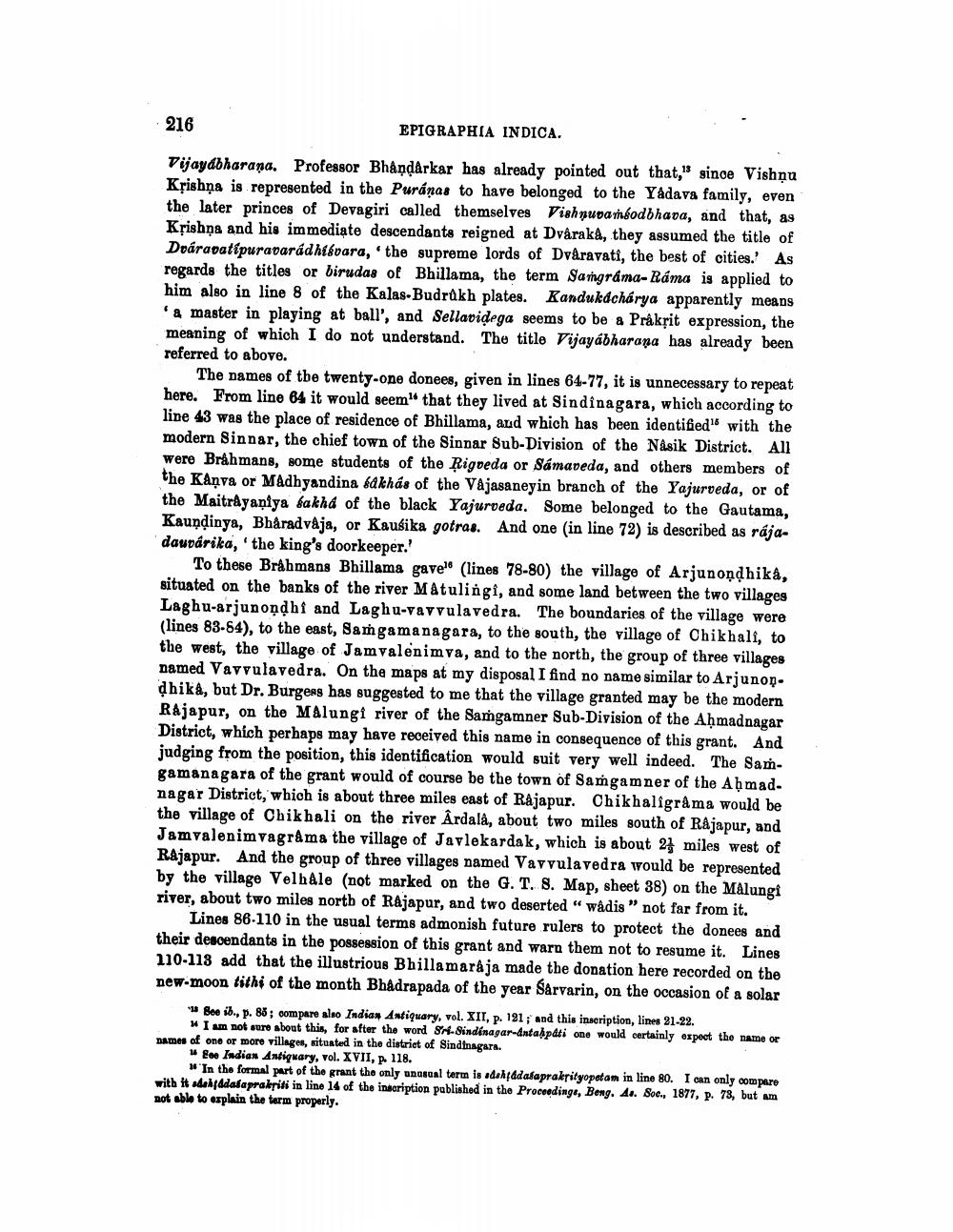________________
216
EPIGRAPHIA INDICA.
Vijayabharana. Professor Bhandarkar has already pointed out that," since Vishņu Krishņa is represented in the Puránas to have belonged to the Yådava family, even the later princes of Devagiri called themselves Vishnupambodbhava, and that, as Krishna and his immediate descendants reigned at Dvaraka, they assumed the title of Dváradatipuravarádhiévara, 'the supreme lords of Dvåravati, the best of cities. As regards the titles or birudas of Bhillama, the term Sangrama-Ráma is applied to him also in line 8 of the Kalas-Budrukh plates. Kandukáchárya apparently means
a master in playing at ball', and Sellavidega seems to be a Pråkrit expression, the meaning of which I do not understand. The title Vijayábharana has already been referred to above.
The names of tbe twenty-one donees, given in lines 64-77, it is unnecessary to repeat here. From line 64 it would seem" that they lived at Sindînagara, which according to line 43 was the place of residence of Bhillama, and which has been identified with the modern Sinnar, the chief town of the Sinnar Sub-Division of the Nasik District. All were Bråhmans, some students of the Rigveda or Sámaveda, and others members of the Kaņva or Madhyandina bdkhás of the Vajasaneyin branch of the Yajurveda, or of the Maitråyaniya bakha of the black Yajurveda. Some belonged to the Gautama, Kauņdinya, Bharadvaja, or Kausika gotras. And one (in line 72) is described as rájadaupárika, 'the king's doorkeeper.'
To these Brahmans Bhillama gave(lines 78-80) the village of Arjunoņdhika, situated on the banks of the river Matulingi, and some land between the two villages Laghu-arjunoņdhi and Laghu-vav vulavedra. The boundaries of the village were (lines 83-84), to the east, Samgamanagara, to the south, the village of Chikhali, to the west, the village of Jamvalenimva, and to the north, the group of three villages named Vavvulavedra. On the maps at my disposal I find no name similar to Arjunoņ. dhika, but Dr. Burgess has suggested to me that the village granted may be the modern Rajapur, on the Malungi river of the Samgamner Sub-Division of the Ahmadnagar District, which perhaps may have received this name in consequence of this grant. And judging from the position, this identification would suit very well indeed. The Samgamanagara of the grant would of course be the town of Samgamner of the Ahmad. nagar District, which is about three miles east of Rajapur. Chikhaligrama would be the village of Chikhali on the river Årdalà, about two miles south of Rajapur, and Jamvalenim vagrama the village of Javlekardak, which is about 2 miles west of Rajapur. And the group of three villages named Vavvulavedra would be represented by the village Velhale (not marked on the G.T. 8. Map, sheet 38) on the Málungi river, about two miles north of Rajapur, and two deserted "wadis" not far from it.
Lines 86.110 in the usual terms admonish future rulers to protect the donees and their descendants in the possession of this grant and warn them not to resume it. Lines 110-118 add that the illustrious Bhillamarája made the donation here recorded on the new-moon tithi of the month Bhadrapada of the year Sarvarin, on the occasion of a solar
" See ib., p. 88; compare also Indian Antiquary, vol. XII, p. 191; and this inscription, lines 21-22.
W I am not sure about this, for after the word SH-Sindinagar-data pati one would certainly expect the name or names of one or more villages, situated in the district of Sindinagara.
Eee Indian Antiquary, vol. XVII, p. 118.
* In the formal part of the grant the only onasaal term is adahfad afaprakrityopetan in line 80. I can only compare with it dolf Adafaprakriti in line 14 of the inscription pablished in the Proceedinge, Bong. As. Soc., 1877, P. 78, but am not able to explain the term properly.




